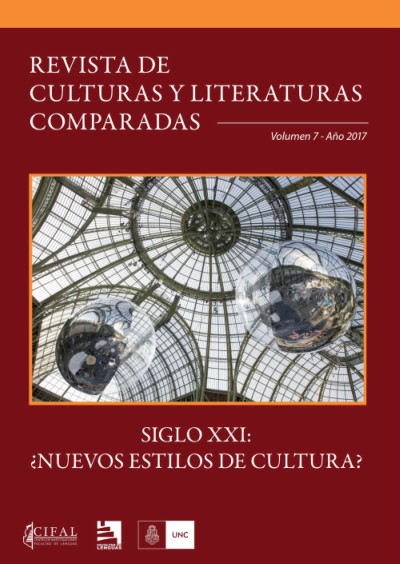Imagining Segregated Spaces: The Spacial Turn in Two Science Fiction Texts
Keywords:
spatial turn, segregation, gheto, critical mobilityAbstract
As for the mid-nineties, and gathering momentum at the beginning of the new millennium, according to geographer Edward Soja (2009), we can observe a spatial turn in literary criticism, and other fields of knowledge such as archeology, law studies, religious studies, among others. This spatial turn entails the reading of different phenomena through a critical conception of space that, in agreement with Foucault's stand on spatiality, considers the social in the production of spatiality, which makes it a possible object for political change, in a dialogic way. The notion of mobility here ascribed is framed within this social concpetion of space, and is therefore political (Cresswell 2011, 2012, 2014, Uteng y Cresswell 2009, Söderström et al. 2013). This article analyzes two representative texts of these current tendencies—the spatial turn and critical mobility--: Ursula Le Guin's “Newton's Dream” (1994) and the film Elysium (2013) directed by Neill Blomkamp. In these texts the spatial dimension is thematized and politized and exposes the power struggles over geography and the imaginations around it, which enable forms of both subjection and resistance.
Downloads
References
Audi, Robert (Ed.). The Cambridge Dictionary of Philosophy. Cambridge: CUP, 1999.
Cresswell, Tim. "Mobilities III: Moving on".Progress in Human Geography 38.5 (Oct. 2014): 712-721. EBSCO host, doi:10.1177/0309132514530316. Web. 27 Mar. 2017.
Elysium . Dir. Neill Blomkamp. TriStar Pictures, 2013.
Huang, Betsy. “Premodern Orientalist Science Fictions”. MELUS 33.4 Alien/Asian (2008): 23-43. Web 27 Set. 2017.
Hutcheon, Linda. The Poetics of Postmodernism. History, Theory, Fiction. New York y Londres: Routledge, 1988.
Le Guin, Ursula K. “Newton's Dream”. Fisherman of the Inland Sea. New York: Harper Collins, 1994.
---. “Introduction”. Fisherman of the Inland Sea. New York: Harper Collins, 1994.
---. The Language of the Night. Essays on Fantasy and Science Fiction . New York: The Women's Press, 1989.
Said, Edward. Culture and Imperialism. New York: Vintage Books, 1994.
Schleifer, Ronald.Modernism and Time. The Logic of Abundance in Literature, Science, and Culture, 1880-1930. Cambridge: Cambridge UP, 2000.
Smith, Stan. The Origins of Modernism: Eliot, Pound, Yeats and the Rhetorics of Renewal . Harvester/Wheatsheaf, 1994.
Söderström, Ola et ál. (Eds.). “Of Mobilities and Moorings: Critical Perspectives” Critical Mobilities. London: Routledge, 2013.
Soja, Edward W. “The City and Spatial Justice”. Justice Spatiale. Spatial Justice n.º 1 (Sep 2009). Web. 10 Mar 2012.
---. Thidspace. Journeys to Los Angeles and Other Real-and-Imagined Places . Massachusetts: Blackwell Publishers, 1996.
Uteng, Tanu Priya & Tim Cresswell. “Gendered Mobilities: Towards an Holistic Understanding”. Gendered Mobilities. Eds. Tanu Priya Uteng & Tim Cresswell. Hampshire & Burlington: Ashgate, 2008. 1-14.
Wacquant, Loïc. “Que é gueto? Construindo um conceito sociológico”. Revista de Sociologia e Política n.° 23: 155-164 Nov. 2004.
Published
How to Cite
Issue
Section
License
Aquellos/as autores/as que tengan publicaciones con esta revista, aceptan los términos siguientes:
a) Los/as autores/as conservarán sus derechos de autor y garantizarán a la revista el derecho de primera publicación de su obra, el cual estará simultáneamente sujeto a la Licencia de reconocimiento de Creative Commons.
b) La cesión de derechos no exclusivos implica que la publicación de los artículos en la presente revista no quita la posibilidad o el derecho al autor/a de publicar su obra de manera posterior en otras revistas u órganos editoriales y la autorización por parte de los/as autores/as para que el trabajo sea depositado en los repositorios institucionales, tales como el Portal de Revistas de la Universidad Nacional de Córdoba.



